July 1-2-3, 2006 – Got the Traveling Blues
At 6:30 pm we picked up our neighbors, Terry and Bev, and Jaime (Terry's son from Madison) and drove to L.A. from San Diego in our rental car – a “5-passenger” Chevy HHR. After being crammed in the center of the back seat, the feeling in my legs was just returning when our Malaysian Airlines flight left LAX at 1:30 in the morning.
I went into my typical autopilot mode passing the time with a good book on Borneo (The Field-Book of a Jungle-Wallah by Charles Hose), a couple of plane meals and some stupid movies plus a nice Ambien-induced snooze.
When we arrived at the colossal new Kuala Lumpur international airport, we met some of our fellow Borneo Adventure travelers – Frieda, Jane and Jimmie and Alex (the newly weds). He couldn’t stop kissing her – so sweet. We had only a couple of hours at the airport until we boarded our final flight – one hour and 45 minutes to the city of Kuching in Borneo.
I was excited at my first peak at the tip of western Borneo from the plane window. I saw so many long snakey rivers crossing the landscape.
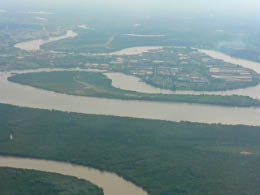
Sarawak's snakey rivers from the air |
Sarawak, the Malaysian state on western Borneo, is the land of many rivers while Sabah, the Malaysian state on eastern Borneo, is the land of mountains.
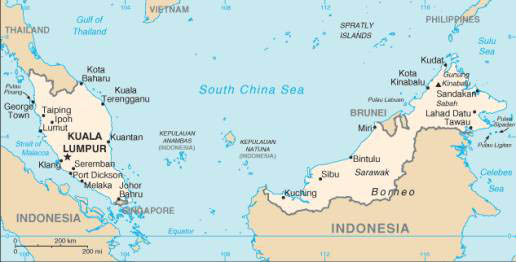
In mid-afternoon, we landed in Kuching, cleared customs, grabbed our suitcases and were quickly herded into the Borneo Adventure bus for our ride to the Crown Plaza Hotel, in the center of town just across from the waterfront.
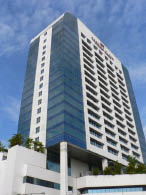 Crown Plaza Hotel Crown Plaza Hotel |
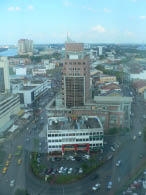 Kuching from our window Kuching from our window |
Thomas Damit, our main guide for the trip, is a sweet, intelligent, gentle man with a bit of mischief in his eyes. He is very much in charge and very organized. We liked him immediately.
Thomas, from the Berawan tribe in the interior of Northern Borneo, grew up in a rain forest longhouse. One of six children, his mother stressed education because she didn’t want her children to be cheated by the Chinese traders, so Thomas completed his education and now travels far from the forest. He is 52 and has 4 children ages 18 months to 23 years – quite the guy. We were lucky to have him as our host in Borneo.
Bill and I showered and then went for a walk along the waterfront – very nice, but very hot and humid.
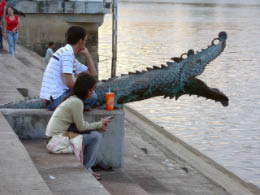
Locals relaxing on the waterfront |
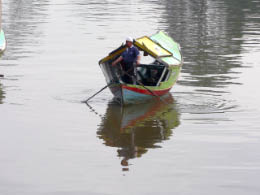
Water Taxi on the Sarawak River |
We tried to buy a beer at the James Brooke bar, but with no ringgits (RM), no dice (or rather no Tiger Beer). We weren’t successful in exchanging our American greenbacks for ringgits. (The moneychangers didn’t like the serial numbers or dates on our hundred dollar bills.)
Without our Tiger Beer, we proceeded to the welcoming buffet on the 3rd floor of the hotel. (Bev crashed once she hit the bed and didn’t join us.) The banquet room was very warm and stuffy. Everyone was tired, but smiling endlessly as we met our new traveling companions. The buffet, mostly Chinese food, was mediocre, but I’m sure our mood had something to do with it. We were glad to get back to the room and go to bed. We’d been in transit for over 30 hours.
July 4, 2006 – Kuching – Our Adventure Begins
At 6:30 am we lined up for a wonderful Hotel breakfast buffet, equipped with an espresso machine and an electric juicer to make fresh orange juice. Life is good again.
At 9 o’clock we boarded the bus for a tour of Kuching – a very pleasant and attractive city. Teddy was our local guy. His father is a Christian minister, but the old minister tells his son, “Religion does not mess with our way of life.” The night before, Teddy helped his dad re-hang his front door in a different location according to the principles of feng shui. Feng shui is serious business in this part of the world -- a way of life for centuries. The arched gates to Kuching’s Chinatown were positioned according to the rising sun. The foundation of the new City Hall had to be retrofitted according to the principles of feng shui, costing taxpayers 50,000,000 RM ($14 million US dollars).
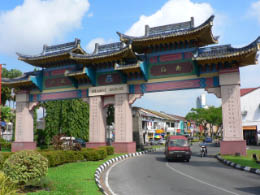
Gate to Chinatown
|
Numbers are also important to the residents – 8 and 9 are lucky numbers, but stay away from 4. People flock to get married in August (especially on 8/8) and avoid marriage in April (especially on 4/4).
Kuching - A little background information …
James Brooke, founder of Kuching, grew up in India as the son of wealthy English parents. His family money came from the East India Company. James used his inheritance to buy a ship and set sail for Borneo in 1838. A little luck and a year later, he established the city of Kuching.
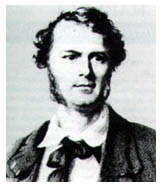 Sir James Brooke, Sir James Brooke,
1803-1868
|
His timing was great. He happened by with his ship when Muda Hassim (of Brunei), uncle of the reigning sultan, was having trouble with the local Dyak tribes. James helped suppress the uprising and, because of his efforts, was made the first White Rajah (Indian word for king) of Sarawak, Borneo in 1841. He created a government to put down headhunting and subdued the raging pirates. He was happy in Borneo. He was a naturalist and loved the rivers and hills, and the animals of Borneo.
It wasn’t long before the British government got involved and made Sir James a baron (gave him lots of land) and entrusted him with the governorship. (By the way, James Brooke was a model for Lord Jim in Joseph Conrad's novel Lord Jim.)
Sir James (or Lord Jim) ruled Sarawak until his death in 1868 and then was succeeded by his nephew, Sir Charles Anthony Johnson Brooke, the second white rajah.
Sir Charles extended the authority of the government to all parts of the country and abolished slavery. His son, Sir Charles Vyner Brooke, succeeded him. Sir Charles was forced out of Sarawak in 1942 when the Japanese invaded during WWII.
After the war in 1946, Sarawak was turned over to the British government as a crown colony. In 1958 Sarawak gained its independence from Britain and in 1963 Sarawak joined Malaya (West Malaysia) and Sabah to form “Malaysia.”
Kuching was originally named Sarawak – meaning “something from the gods.” The river that flows through the city is called the Sarawak. (Water is critical to the tribes and indeed “something from the gods.”)
Teddy, our local guide, said the Sarawak River that runs through the city is free of crocodiles, but 80% of the rivers outside the city are infested. From 7 pm to midnight crocs are the most active. One evening Teddy was out with his buddies, drinking beer and doing a little spear-fishing when he accidentally grabbed a crocodile’s tail. He’s lucky it was only a small crocodile and he only needed 18 stitches.
In 1872, Charles Brooke (nephew of James) changed the city’s name to Kuching, meaning “cat” in Malay (probably because of the many wild cats found along the banks of the river and from “Cat Hill.”) The city has a cat museum and statues to cats everywhere – a great place for cat lovers.
In 1988 the city was divided into two separate parts – South of the river (mostly Chinese) and North of the river (mostly Malay). There are two mayors, two town halls – one for the north and one for the south. Each year, they have competitions (and rewards) between the two city governments.
The city is multi-cultural and diversity is embraced. Everyone loves the extra days off to celebrate all the holidays of the different religions and cultures.
Malaysian Muslims tend to be liberal and accepting of other religions and cultures.
Statistics:
The population of Kuching is half a million – 40% Malay and 35% Chinese – and the rest indigenous peoples, Indian . |
Our first stop in the city was at the ornately decorated Tua Pek Kong Temple, opposite the waterfront. It is the oldest Chinese temple in Kuching, first built in 1776 and then rebuilt in 1876. The temple is a place people go to honor the dead. “Altar” ladies sell packets of yellow tissue type paper (representing mock money), incense sticks and red candles which are offered along with prayers to pay respects to the dearly departed.
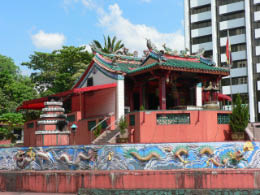
Tau Pek Kong Temple |
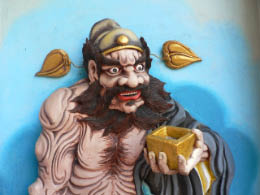
Temple art |
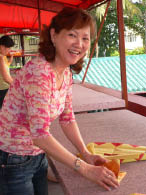
The "Altar Lady" at the Temple |
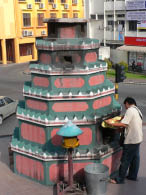
Offering respects to the departed |
We made another stop to snap a few photos of the South City Hall – a weird building shaped like an upside down umbrella, but beautifully landscaped.
We only had 45 minutes “to do” the Sarawak Museum. The old wing was completed in 1891 under Charles Brooke’s reign. An English Architect friend of his designed it to look like a chateau in Normandy.
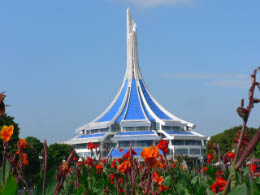
Kuching South City Hall |
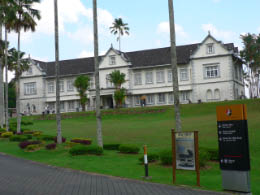
Sarawak Museum |
I loved the old wooden cases on the main floor filled with musty threadbare stuffed animals. The species were clearly labeled on each case in white paint (e.g., Flying Squirrels, Orangutans, Hornbills, Bats, Wild Cats). One case displayed actual items taken from a local crocodile’s stomach—a Seiko watch, someone’s dentures and a hairball.
Upstairs is a model of a fully fitted out longhouse complete with skulls hanging from the ceiling cross beams, woven mats, dishes held in rattan casings and other everyday household items. The early photos of smiling, sweaty, insect-bitten tribes folk fascinated me.
There were also exhibits of musical instruments, handicrafts and one display that intrigued us all – a display explaining the centuries-old practice of palang – where jewels and other things are inserted into a man’s penis in order to enhance his love making. (Thomas tried to explain it on the bus ride back to the hotel, with little luck. Goggle “palang” on the Internet – you’ll be amazed at what you find!)
I loved the simplicity of the old museum and the musty smells left over from the 1900’s. To me the place was a museum of a museum when museums were really popular and THE PLACE to go. (Charles Hose, the author of the book I read on the plane (The Field-Book of a Jungle-Wallah), was a friend of Charles Brooke and made several expeditions into the interior of Borneo to collect animals, insects and plants – some are probably still on display. I loved getting insights of his gathering missions and his meetings with Sir Charles.)
I just had time to check out the old aquarium at the back of the museum before it was time to board the bus. The small building needed repair, but oh so fascinating. I was able to view a needle nosed crocodile, brightly colored catfish and catfish that swam upside down, ghost fish, pencil fish and other very odd river creatures.
Before we left, Thomas pointed out a well-weathered wooden totem pole on the museum grounds. With pride, he explained that the totem pole is from his Berawan tribe. Ashes of tribe members are placed in an urn in the pole.
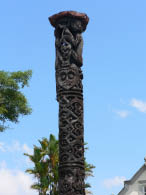
Berawan Totem Pole |
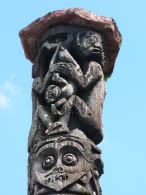
Totem Art |
The bus took us back to the hotel where Bill and I gobbled down some bread and cheese (left over from breakfast) and mapped out our afternoon excursion into the city on our own.
We joined Terry, Bev and Jaime and arranged a tour for the next day at Bako National Park. Then we walked along the waterfront – the same waterfront where James Brooke anchored his ship – but then it was a busy and dirty harbor. Now it is peaceful and quiet and nicely landscaped.
We did our sightseeing while combing the area for banks and moneychangers who would accept our bills. I loved the old neighborhoods with their winding streets. We passed through Malay, Indian, Muslim and other ethic sections of town.

Intrepid Travelers |
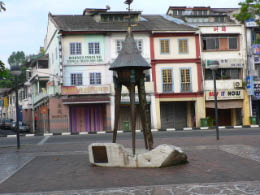
Kuching Sites |
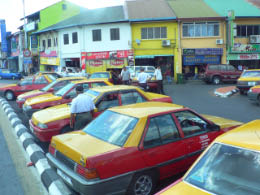
Kuching Sites |
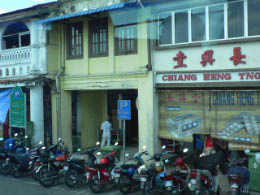
Kuching Sites |
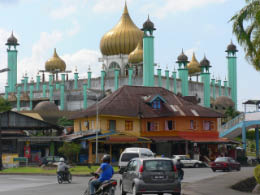
Kuching Sites
|
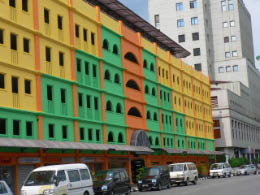
Kuching Sites |
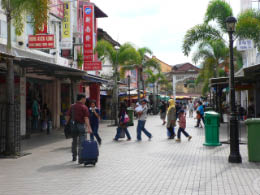
Kuching Sites
|
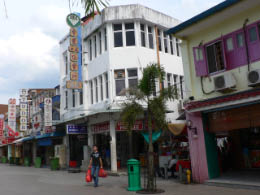
Kuching Sites |
We checked out the Chinese Museum by the waterfront. It was established by the White Raja as a trade and community hall for the Chinese. Exhibits included a large dragon used for the Chinese New Year, manikins in traditional dress, musical instruments and wonderful old black and white photos tracing the history of the Chinese in Sarawak.
Further down on the waterfront we saw a small white castle. Originally it was a prison, but now it’s a place to go and enjoy music. Everyday at teatime the fountain outside dances to music – if someone remembers to turn it on.
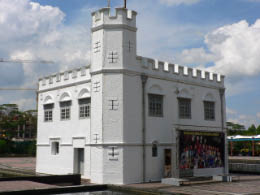 White Castle (But no hamburgers) |
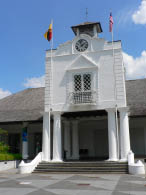 Old City Hall |
Right across the street from the prison is the Old City Hall, now a Tourist and Information Office. I bought a cool camouflage hiking hat there. The Old City Hall was built close to the castle prison out of necessity. When a headhunter was convicted of his crime at City Hall, the guards wanted to escort him only a short distance to the prison because often his headhunting buddies would be waiting to kill the guard and free their friend.
We wandered back to the Sarawak Museum – this time to check out the new wing that we missed on our morning visit. An art show “Portraits from My World” by New Yorker, Stephen Bennett, was the main exhibit. We were drawn into his huge colorful portraits of ethnic faces with their haunting eyes. Stephen was there, hanging out with the local kids when he wasn’t painting a colorful portrait of an orangutan on a huge canvas hung upside down. Being a really friendly type, he came up to introduce himself. As part of my small talk, I commented that he probably ended up in Borneo because of an old girlfriend. He was surprised by my accuracy and immediately told me about his ex-girlfriend who left him with a very broken heart only 3 months ago. (So Stephen, if you’re reading this, I hope the pain has gone away.)
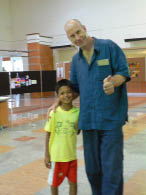
Artist Stephen Bennett |

Portrait by Steven Bennett |
We ambled back to the waterfront, still in search of a moneychanger. Bev was hot and tired and went back to the hotel, but Terry, Jaime, Bill and I still had a little energy left so we caught a water taxi (tambang) for 30 sen ($.10) across the Sarawak River to visit Fort Margherita. Lacking adequate boat loading skills, we almost capsized the poor little water taxi, much to the delight of the school kids inside.
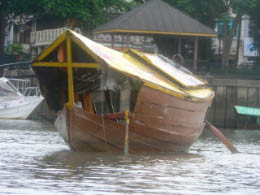
Crossing the Sarawak |
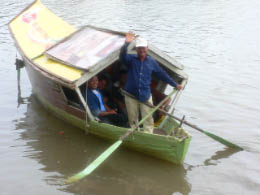
Our "taxi" driver |
We disembarked and walked by a massive construction project with warning signs posted: “Ft. Margherita – This Way – Enter at your own risk.” The steps uphill and the rickety bridge crossing were a little precarious, but added to the sense of adventure.
Fort Margherita, named after Raja Charles Brooke's wife, Renee Margaret, was erected in 1870 to protect the city of Kuching. The very English white castle-like fort is now a police museum adored with strange life-sized cartoon faced dummies.
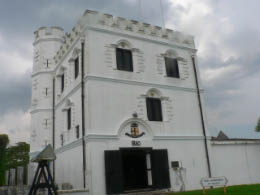
Fort Margherita |
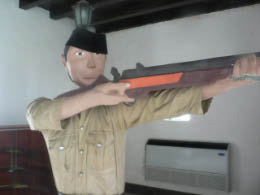
"Soldier" at Fort Margherita |
It was very hot and humid as we climbed up the wall to the guard towers, but the views of the city across the river were spectacular. We ran out of energy just about the time the battery in my camera run out of juice, so we caught another water taxi back across the river.
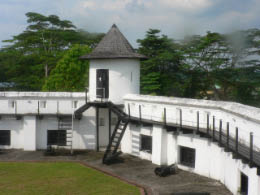
Fort Margherita |
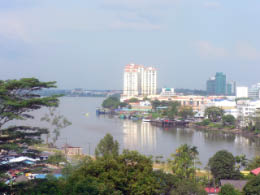
View of Kuching from the Fort |
We stopped at “James Brooke,” the same watering hole Bill and I tried to get a beer the night before, but now we had ringgets to trade for a Tiger beer. It was so pleasant sitting out in the light breeze overlooking the waterfront, drinking our Tigers and sharing all the things we had done that day – This is the life!
We went back to the hotel, showered and then headed to the highly recommended Top Spot for dinner. We were surprised to find a massive food court with several stalls all displaying piles of fresh fish and other sea creatures. We were all overwhelmed, except for Bill, who selected the vendor with the freshest fish (the lobsters were still fighting for their lives) and found the nicest server to guide us through this new experience. With her help, Bill and I picked out our food (lobster, tiger prawns, rockfish with blue polka-dots and an assortment of fresh veggies). Next we selected the method of preparation for each entree and finally tallied the bill. Man-oh-Man, it was the best seafood Bill and I ever tasted and only cost about $15 each including giant Tiger beers.
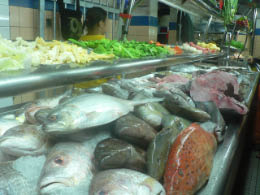
Top Spot Food Court |
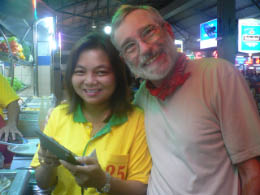
Bill with Our Top Spot Server |
Bill and I returned to our rooms, tired, but fat and happy. |











